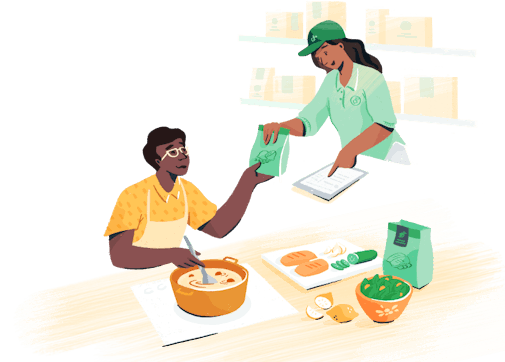Recently, my wife and I made it to a trendy noodle house we’ve been eager to try.
Hip music played as we entered the beautifully renovated restaurant. We were seated at a chic table, and greeted promptly. After ordering tea, perusing the menu and asking our server a few uninspired questions, to which we received equally uninspired answers, we ordered dumplings, Korean fried chicken, and an eel dish.
We then proceeded to have a perfectly average experience, and haven’t been back.
5 simple steps to turn first-time customers into repeat customers
In today’s competitive climate, an average experience does not yield the holy grail — the almighty loyal customer. It can be between five and 25 times more expensive to attract a new customer than it is to retain a current one. Furthermore, compared to new customers, return customers are 50% more likely to try new products and spend an average of 31% more. And if that’s not enough, increasing customer retention rates by just 5% can have a profound impact, including an increase in profits by as much as 95%.
Loyal customers play a vital role in the success of a business — this is no longer in question. The new question is, how can small businesses ensure that first-time customers become loyal customers?
Small businesses can use these five universally applicable strategies to increase the likelihood that new customers become repeat customers.
1. Recognize a new customer
Before you can provide a new customer with an exceptional experience, you have to identify them as new. This can (and should) be relatively simple and straightforward.
An effective greeting by a host, salesperson, or server can include, “Have you (shopped or dined) with us before?” If diners make a phone reservation, the person assisting can ask the same question and make note of the answer. Likewise, if a salesperson receives a call about the availability of a certain item, the salesperson can ask the same question.
If the time to ask this question has passed, seek non-verbal cues: Is the customer paying especially close attention to scenery or the menu? Are they viewing a product for an unusually long time? Is there a puzzled look on their face or are they pointing things out to their fellow guests? Do they have multiple questions?
The earlier you recognize a new customer, the sooner you can seize control and take steps to ensure their experience is exceptional.
2. Put your best foot forward
Once you’ve identified a new customer, ensure you put your best foot forward. This means taking early action by assigning a quality salesperson or server to the new customer, and where available, oversight by a floor manager.
In a restaurant, for example, a manager can greet a new customer at the host’s stand, present them with a particularly attractive table, assign an experienced server to them, notify the server of their first-time status, ensure they do not wait too long, and perhaps even provide a complimentary product to begin the experience on a positive note.
In a retail establishment, this may mean arranging for a salesperson with broad knowledge of your offerings to assist a first-time customer and treat them with extra attention. If the customer inquires about a specific item, assure them that your resident expert on that item is available to assist. A customer will happily wait a reasonable amount of time for the expert if they are busy, and will appreciate the special attention if delivered honestly and in a straightforward manner.
3. Put your best product front and center
Together with exceptional service, an exceptional product is integral to an exceptional experience. Not every retail establishment or restaurant can specialize in every offering. As the saying goes, a jack of all trades is a master of none.
Let’s think back to the beginning of this article, at the noodle shop. The place has the word “noodle” in its name. It specializes in noodles. And yet, my wife and I left the shop without eating or even viewing a single noodle.
Always do your best to put your strongest offering or product you’re known for in front of a first-time customer and let them experience it with their senses. Recommend, encourage, and be assertive. Provide first-time customers with a sample or let them experience it for themselves, even if they don’t purchase it.
Provide a tasting of the gnocchi to the table compliments of the chef. Put the Tibetan cashmere wool sweater in the customer’s hands and encourage them to touch their neck with it to feel its softness. Hand them a high-end pair of trail running shoes and allow them to feel the depth of the lugs or encourage them to try on your most cushioned neutral runners, if even for a frame of reference.
Along with providing a more positive experience, ensuring a customer experiences your best product firsthand also increases the likelihood of a personal recommendation to their friends and family, which is the most effective form of advertising.
4. Educate with differentiating, positive details
You know why your product or service is superior or distinguishable to competitors, but does your customer? If they are a first-time customer, they probably don’t. Highlight positive elements of your offering to draw their attention to it.
This step requires preparation, anticipation, and sales acumen. Team members can prepare for this step by learning a dozen or so small, positive details about your offering that may otherwise be overlooked.
Giving your customer a piece of information that differentiates you from the competition gives them something positive to focus on, and the cost is only a few seconds of your time. It is a simple, effective device to enhance a first-time customer’s experience and ensure your strongest assets do not go overlooked.
5. Plant a seed to ensure future customer interactions
Once you’ve ensured a first-time customer has an exceptional experience, plant a seed with that customer for a second interaction. Planting a seed is more involved and requires follow-up, but it’s an effective tool in creating a trusting relationship between an establishment and a customer.
You can plant a seed to ensure a second interaction with your customer in various ways, but common threads are assertiveness and persistence. Customers appreciate when a business is straightforward about their intentions. A few examples include:
“I will be attending a runner’s conference next month. Representatives from Brand X will be there and they specialize in wide toe-box running shoes. I will speak to them about the issues we’ve discussed today and find you a solution. I’d love to have your contact information to follow up with you after the conference.”
“I’m glad you enjoyed the rosemary chicken. Our chef Cassandra is brilliant in her use of herbs. Here is our manager’s card with a personal note on the back. He would love to treat you to our sage-crusted braised short-rib appetizer next time you dine with us.”
“This power-sander should be the perfect tool for your job. As a show of appreciation, we’d love to service all of your power tools at a complimentary or preferred rate. Here is my card – I wrote ‘March 1’ on the back to remind you that it may be a good time to service any power tools used for spring chores, such as your lawnmower. I would appreciate the opportunity to earn your continued business and we’ll do everything we can to accommodate your busy schedule, including delivery.”
By planting a seed for future interactions you express appreciation for a customer’s business. This is a simple concept and you should strive for a simple execution.
Small businesses can’t afford not to invest in customer experience
The steps illustrated above should be employed as part of a comprehensive customer experience strategy, but even if you don’t have one in place, they are good starting points to consider.
Providing an exceptional customer experience requires true investment, but a growing body of evidence shows it is a worthwhile investment. Ensuring first-time customers become repeat customers should not be left to chance.



